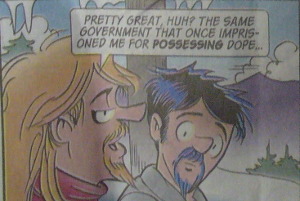1) put in police More on Arizona's youngest pot smoker http://www.azcentral.com/insiders/ejmontini/2013/11/14/justice-for-zander-is-medicinal-pot-oil/ Posted on November 14, 2013 5:07 pm by EJ Montini ‘Justice’ for Zander is medicinal pot oil We can’t expect an ill, autistic five-year-old boy to understand the complex needs of the American juridical system. But we can, and should, expect the judicial system to understand the complex needs of an ill, autistic five-year-old boy. His name is Zander Welton. He is autistic and he suffers from a medical condition that causes debilitating seizures. This week, lawyers from the American Civil Liberties Union asked a Maricopa County Superior Court judge to grant an injunction allowing Zander’s parents to resume treating their son with a medical marijuana extract. If they were to do so now, given the way Arizona prosecutors have chosen to interpret the state’s medical marijuana law, Zander’s parents could be arrested. They worry about the impact that would have on Zander and their other children. Zander was treated with a number of traditional and experimental medications, as well as surgery, before his parents acquired a medical marijuana card for their son and tried cannabis oil. In their injunction request with the court Zander’s attorneys write: “Jacob and Jennifer have seen significant positive changes in Zander since he began taking medical marijuana. He is showing signs of wanting emotional stimulation and notices that people are people, not inanimate objects. Zander is seeking attention and climbs into his parents’ laps when he wants comfort or love. “He is actively trying to play with his brothers and he recognizes his parents’ laughter and responds with his own laughter. Zander’s physical development has also improved … “In addition to Zander’s intellectual, emotional, and physical improvements since he started taking medical marijuana, his seizures have significantly decreased. Amazingly, Zander has had only two confirmed seizures since he started taking medical marijuana and both were considerably shorter than the seizures he experience before…” The couple recently discovered they could be arrested for using the extract, however. As a result, the ACLU filed a lawsuit on behalf of Zander. Maricopa County Attorney Bill Montgomery is named in the suit. As well as the Gov. Jan Brewer. Montgomery believes the extract is illegal. Arizona’s medical marijuana act doesn’t mention extract, only dry ounces of the plant. (Zander can still use marijuana that way, but it’s less effective.) The problem faced by police and prosecutors is determining the legality or illegality of whatever amount of extract a person possesses. Science has provided some answers to that question. But they haven’t been incorporated into Arizona’s guidelines. State officials and legislators don’t want to do that. They’d rather argue the case in court. As a result, Zander and his family are caught in a political battle while they’re trying to wage a medical war. A case like this can take a long time to be resolved. Zander’s attorneys hope the judge will grant the injunction so he can get the help he needs quckly. Earlier this month, Jennifer Welton told me, “What if there was a medicine available to help your sick child and you are being told if you use it you’ll be arrested? And then if you get arrested maybe this child and your other children will be taken away from you.” No parent should be placed in that position. Not based on politics. The governor and the county attorney really, really don’t like Arizona’s medical marijuana law. They have done all they can to undermine it. Kelly J. Flood, one of the attorneys representing Zander and his parents told me, “We have asked for the preliminary injunction even before we’ve received any answers from the defendants. So we’re hoping to move along fairly quickly.” Lawyers from the county and state will get an opportunity to reply, of course. And there probably will be oral arguments before the judge. At best the process could take a couple of weeks. But it could linger for months. And the judge might rule against the injunction. We just don’t know. All we know for sure is that if the state prevails in court it will be at the expense of an ill, autistic five-year-old boy. “It’s a really tough spot,” Jennifer Welton told me, “It seems crazy to us.” It should.
1) put in police too You want a fair trial??? Don't make me laugh!!! Ask Ray Krone, Debra Milke, or the Tucson 4 who where arrested for murder in the Buddhist Tempe Murders!!!! Of course don't expect the prosecutors to obey this new rule any more then they obey the old "discovery rules" which require them to provide the defendants with any evidence that could help them prove their innocence. http://www.azcentral.com/news/articles/20131114ariz-prosecutors-must-now-reveal-evidence-convicts-innocence.html Ariz. prosecutors must now reveal evidence of convicts’ innocence By Michael Kiefer The Republic | azcentral.com Thu Nov 14, 2013 10:14 PM If Arizona prosecutors find evidence that shows a convicted person may actually be innocent, they must turn it over to the convict’s defense attorneys, according to a new rule for lawyers enacted Thursday by the Arizona Supreme Court. And if the prosecutors find “clear and convincing evidence” that a defendant is not guilty, according to the amended rule, they must take steps to have the conviction reversed. The rule was approved over the objection of state prosecutors, who say it is unnecessary. Maricopa County Attorney Bill Montgomery, one of the prosecutors who opposed the change, declined to comment for The Arizona Republic. The objection to the proposal filed under his name last month said that “we have no real-world examples of prosecutors discovering evidence of the nature that would trigger a duty under this rule.” “Prosecutors in Arizona already fully embrace their roles as ministers of justice when (it) comes to righting wrongful convictions,” the filing said. The objection cited the fact that Montgomery’s office recently filed motions to drop charges against people who pleaded guilty to “huffing,” that is, intentionally inhaling toxic vapors to get high, when it was discovered that the office had misinterpreted the law. However, at least one case contests the notion that prosecutors always turn over such exculpatory evidence. In 1999, a man named Henry Hall was sent to death row for the murder of Ted Lindberry, based largely on the testimony of a jailhouse informant who claimed that Hall had described to him how he had smashed Lindberry’s skull and dumped his body in the desert east of Phoenix. The body had not yet been found when Hall was sentenced to death. But by the time Hall’s conviction and sentence were overturned by the Arizona Supreme Court because of juror misconduct in 2001, Lindberry’s skeletal remains had been located in the desert west of Phoenix. His skull was not caved in. The remains were released to Lindberry’s family and cremated. Hall’s defense attorneys did not learn about the new exculpatory evidence until approximately a year after the remains had been destroyed, according to court documents. The informant had since died. But Maricopa County prosecutors wanted to use the informant’s testimony in Hall’s retrial. Superior Court Judge Roland Steinle refused to allow the testimony because it was proved to be false and because the informant could not be challenged because he was dead. And as a sanction for not disclosing the discovery of the skeletal remains, Steinle agreed to allow the defense attorneys to inform the jury of the lapse. The prosecutors took the case to the Arizona Court of Appeals, still planning to use the false informant testimony. In 2011, the appellate court denied the appeal (as well as a request by the defense to throw out the case for prosecutorial misconduct). Prosecutors allowed Hall to plead to second-degree murder and a prison sentence of 16 years; he had already served more than 13. Montgomery also declined to comment on the Hall case. If the new amendment, known as Rule 3.8, had been in effect at the time of Hall’s conviction, it would have made the prosecutor’s duty obvious, though it would not have guaranteed that Hall’s first-degree conviction would have been overturned. The amended Rule 3.8 to the Arizona Rules of Professional Conduct is modeled on rules suggested by the American Bar Association in 2008. The text of the amendment says, “When a prosecutor knows of new, credible, and material evidence creating a reasonable likelihood that a convicted defendant did not commit an offense of which the defendant was convicted, the prosecutor shall: “(1) promptly disclose that evidence to the court in which the defendant was convicted and to the corresponding prosecutorial authority, and to defendant’s counsel. ... “(2) if the judgment of conviction was entered by a court in which the prosecutor exercises prosecutorial authority, make reasonable efforts to inquire into the matter or to refer the matter to the appropriate law enforcement or prosecutorial agency for its investigation into the matter.” The amendment goes on to say that when a prosecutor learns that a defendant is not guilty, “the prosecutor shall take appropriate steps, including giving notice to the victim, to set aside the conviction.” Defense attorney Larry Hammond, one of the petitioners who proposed the amendment in 2011, called it “an important step forward to make as sure as we can that there are no people who are not guilty who remain in our prison.” But the state’s prosecutors tried to dissuade the Supreme Court from making the amendment. Pima County Attorney Barbara LaWall wrote in her comments filed with the Supreme Court that she could not order law enforcement to conduct investigations into new evidence and worried that the rule would force prosecutors to investigate the numerous claims of innocence by the state’s prison populations. LaWall did not respond to a request for comment. The comments by Montgomery’s office, filed by Chief Deputy County Attorney Mark Faull, called the investigations “unfunded mandates” and said, “The rule will subject honest, hard-working prosecutors to unnecessary Bar complaints where the burden will be on the prosecutor to prove that his or her action or inaction was ‘in good faith.’ ” Yavapai County Attorney Sheila Polk, representing the Arizona Prosecuting Attorneys’ Advisory Council, called the changes “unnecessary, confusing, impractical, and a solution in search of a problem” in her filings with the high court. She wrote that prosecutors could not be ordered to do investigations and noted that some counties do not have a public defender’s office to contact, as required in the amendment. Polk also did not respond to a request for comment. The Supreme Court and Chief Justice Rebecca White Berch disagreed with the prosecutors. The amendment “highlights the special duty of prosecutors to act as ministers of justice and not as advocates who seek to obtain convictions at all costs,” Berch said in an e-mail to The Republic. She added: “It requires affirmative steps to be taken when it appears that a defendant might have been wrongfully convicted. “Prosecutors represent all citizens, and therefore they (like judges) are held to higher standard and should help remedy any errors that result from our sometimes imperfect system of justice.”
http://eastvalleytribune.com/arizona/capitol_media_services/article_e931e67a-4bdf-11e3-8092-0019bb2963f4.html Libertarian Party wants judge to impose oversight for elections Posted: Tuesday, November 12, 2013 5:00 pm By Howard Fischer, Capitol Media Services PHOENIX — Calling machine-counted voting ripe for fraud, an attorney for the Pima County Libertarian Party asked the state Court of Appeals Tuesday to let trial judges statewide impose new oversight procedures. William Risner said the protections in existing state laws against tampering with results are insufficient to combat the ease of tinkering with the computerized system that tallies the ballots and spits out a report of what it has found. “Right now there is a black box,” he told the judges. “Not a single ballot, for any county race or bond election is ever audited,” Risner continued. “You don't know if the machine counted wrong.” But under questioning from Judge Kent Cattani, Risner said the procedures for monitoring national and statewide races is little better, even with the possibility of audits. Risner said he believes these, too, can be rigged by anyone with decent computer skills. The fight is most immediately an outgrowth of a 2006 election in Pima County to levy a half-cent sales tax for 20 years to raise $2 billion for regional transportation improvements. It's too late for Risner and those who believe that election was rigged to change the outcome or get rid of the levy. But he wants the appellate judges to let him prove that the results were not as advertised — and then use that evidence to get them to put procedures in place to prevent future problems. That could have statewide implications if he succeeds. It would pave the way for judges to order additional oversight of virtually any future political contest or ballot measure. The possibility appeared to concern the appellate judges. Cattani suggested to Risner if he and his clients find the existing oversight procedures in state law inadequate they should probably take their case to the Legislature. “I wish the Legislature would address this,” Risner responded. But he said that does not preclude the courts from stepping in to protect the rights of voters. “The courts have a responsibility,” he said, saying it's no different than asking a judge to step in to protect an individual's First Amendment rights. Risner specifically wants courts to allow for “graphic scanning” of ballots. In essence, the original paper ballots would be counted as they are now by tabulating equipment. Then pictures would be taken of the same ballots, with separate — and independent — equipment tallying the votes and comparing them with what the county's own equipment found. “Graphic scanning sounds like a good idea,” said Judge John Gemmill. Attorney Ronna Fickbohm, representing Pima County, said that's legally irrelevant. She said state law sets out the procedures for exactly what can — and cannot — be done with ballots. That includes a requirement that, after official counting, they be sealed and, unless there is a court challenge, be destroyed. Fickbohm said Risner or anyone who wants graphic scanning needs to have the Legislature amend the laws. She told the judges their authority is not unlimited. Fickbohm said the Arizona Constitution prohibits courts from getting into areas reserved for the Legislature. She said what Risner wants, in essence, is an injunction — a court order — requiring certain procedures be put into place, beyond what is required by state law, to ensure election results are as advertised. “You can't use an injunction to say, ‘Hey, judge, I've got a better idea about how the statute should read than what the Legislature's done,’” she said. Risner said, though, courts can step in and order special oversight if there is evidence of prior rigging. And that's why one of the things he wants a court to provide is access to the ballots from the 2006 Pima election, which are still locked away in the county treasurer's office. Risner said it should not be necessary for him to prove the 2006 election was rigged to get more safeguards put into place. “What we can show is that it is easy to rig them, and there's nothing you can do about it,” he said. Risner also said he does not even have to prove that there is a probability that a specific future election would be rigged to get court intervention. He said it's just a question of using common sense, like noting it's easy to defraud a bank which lacks proper accounting procedures. “So really the issue is not probability” of future fraud, he said. “It's the ease that elections can be rigged and the inability to do anything about it, to prove it, to audit it, to check it.” The judges gave no indication when they will rule.
Robert Robb exposes some lies of Phoenix Mayor Greg Stanton???? Sadly our elected officials seem to think the facts are how things should be, not how they actually are!!!! Again reminds me of Scott Henderson!!!! http://www.azcentral.com/insiders/robertrobb/2013/11/13/stanton-what-unfunded-liability/ Posted on November 13, 2013 11:41 am by Robert Robb Stanton: What unfunded liability? I tried to defend the City of Phoenix for the modest anti-pension spiking provisions it adopted. But, man, does Phoenix Mayor Greg Stanton make it hard. The city did not eliminate spiking. But it did cap the most costly spike – making unused leave time pensionable – for existing employees and forbid it for new workers. That’s worth doing, and doing more did face potentially deadly legal obstacles. But then Stanton took to the pages of the Republic to defend the measure, making the claim that: “We are putting the pension system on track to be 100 percent funded.” Huh? The pension system is currently only 62 percent funded, with an unfunded liability of $1.1 billion. The city has done virtually nothing to address this unfunded liability. The previous pension reform adopted by voters mostly increased the contribution rate of new workers. That reduces the contribution rate of the city, but does nothing to reduce the unfunded liability. That measure only modestly reduced the unfunded liability by increasing the retirement age with full benefits by about three years. Stanton says that the city’s anti-spiking reforms will save $130 million over time. That still leaves an unfunded liability of around $1 billion. 2013 was a good year for the stock market, so presumably the unfunded liability will shrink somewhat as a result. But in 2014, new accounting rules will require cities with unfunded liabilities to restate them with a much lower investment assumption, which will drive it considerably higher. Stanton’s position is that the pension system is now fixed. Nothing more to see or do here. And that’s the fundamental problem. For Stanton and most of city hall, the pension system is a political issue to finessed, not an unsustainable taxpayer burden to be solved.
You expect a fair trial??? Don't make me laugh!!! If the government thinks you are a criminal there is a good chance you will be railroaded!!!! This case isn't unique and I have posted similar articles before where the prosecutors refused to provide evidence to the defense which would prove the defendant is innocent. http://www.miamiherald.com/2013/11/12/3748623/marathon-suspects-lawyers-seek.html Marathon suspect's lawyers seek evidence from feds By DENISE LAVOIE AP Legal Affairs Writer BOSTON -- Lawyers for Boston Marathon bombing suspect Dzhokhar Tsarnaev renewed their accusations Tuesday that prosecutors are withholding evidence they need to defend their client against a potential death penalty. Tsarnaev's lawyers complained that prosecutors have failed to turn over several types of evidence they believe could help them argue against the death penalty, including information on a 2011 triple slaying in Waltham in which Tsarnaev's older brother, Tamerlan, is a suspect. Miriam Conrad, one of Tsarnaev's lawyers, told the judge that the defense has also been frustrated by the government's refusal to turn over the immigration files of Tsarnaev's family and friends, information she said could also be used to argue against the death penalty. "The government could provide it, and has not offered a single reason why it won't," she said. Assistant U.S. Attorney William Weinreb countered that prosecutors have turned over "virtually all of the mitigating evidence" they have. "We have not withheld any favorable information from them," he said. In court documents filed last month, prosecutors acknowledged that a friend of Tamerlan Tsarnaev told investigators that Tamerlan participated in the unsolved killings of three men who were found in a Waltham apartment with their throats slit and marijuana sprinkled over their bodies. Dzhokhar Tsarnaev's lawyers argued in court papers that any evidence of Tamerlan's involvement is mitigating information that is important as they prepare to defend his brother in the marathon bombing. His lawyers haven't said why they consider the evidence to be mitigating, but legal experts have theorized that the defense may be trying to show that Dzhokhar fell under the murderous influence of his older brother and that Tamerlan was the driving force behind the marathon bombings. Conrad reiterated the defense request Tuesday and asked Judge George O'Toole Jr. to order prosecutors to turn over the records in the triple murder or at least review the file to see whether the information can be shared with the defense. Federal prosecutors have said they won't provide the records because state prosecutors are in the middle of an ongoing investigation into the killings and releasing details could jeopardize the investigation. Authorities have alleged that the Tsarnaev brothers built and planted two pressure cooker bombs near the finish line of the April 15 marathon to retaliate against the United States for U.S. military action in Muslim countries. The explosions killed three people and injured more than 260. Tsarnaev, his parents and siblings, ethnic Chechens from Russia, came to the United States about a decade ago and lived in Cambridge. Tsarnaev, 20, has pleaded not guilty to a 30-count federal indictment that includes charges of using a weapon of mass destruction. Seventeen of the charges carry a possible death penalty. Prosecutors said they are in the process of completing their written proposal to U.S. Attorney General Eric Holder, who will make the decision on whether to seek the death penalty against Tsarnaev. Holder is expected to decide by Jan. 31. Tsarnaev's lawyers also asked the judge to ease restrictions placed on Tsarnaev in prison, arguing that they are inhibiting their ability to defend him. The measures, which are often used in terrorism cases, restrict a defendant's access to the mail, the media, the telephone and visitors. O'Toole took both defense motions under advisement and did not immediately rule. The judge rejected a request from prosecutors to schedule Tsarnaev's trial for next fall, saying it was too early to decide on a trial date. The next status conference was scheduled for Feb. 12.
Let me get this straight!!!! 6 million people die every year world wide from the harmful effects of legal tobacco use. 2.5 million people die every year world wide from the harmful effects of legal alcohol use. And 0, thats a big zero people die world wide from illegal marijuana use. And these folks are worried that a few silly molds and other krap are going to cause an epidemic of sickness from smoking marijuana???? About the only use I can see for testing of marijuana is by the medical marijuana stores that test it and try to justify their outrageousness $300+ an ounce price which is about 5 or 6 times the $50 to $70 an ounce black market price of marijuana in Phoenix!!!! About the only possible legitimate use of marijuana testing would be for back when the US government was poisoning marijuana users by spraying marijuana in Mexico and other Central American countries with paraquat! But allegedly that outrageous practice by the American government has stopped! http://www.azcentral.com/news/free/20131201conn-university-test-pot-contaminants.html Conn. university to test pot for contaminants Associated Press Sun Dec 1, 2013 11:12 AM WEST HAVEN, Conn. — The microscope at the University of New Haven, set at 10-times magnification, shows a marijuana leaf covered with dozens of tiny bumps. It’s mold, and someone, somewhere could be smoking similarly contaminated pot and not have a clue. Heather Miller Coyle, a forensic botanist and associate professor at the university, says all sorts of nasty things not visible to the naked eye have been found in marijuana — mold, mildew, insect parts, salmonella and E. coli, to name a few. That’s why Coyle and her students earlier this year began developing a new process to detect contaminants in marijuana through DNA profiling and analysis. The aim is to be able to identify potentially harmful substances through a testing method that could make the analysis easier and quicker for labs across the country in the developing industry of marijuana quality control testing. Twenty states and Washington, D.C., now allow medical marijuana with a doctor’s recommendation, and Washington state and Colorado have legalized the recreational pot use. Connecticut and Washington state already require testing and other states are doing the same, spawning a testing industry. “If there’s no certification … it’s like saying we don’t check our meat for mad cow disease,” Coyle said. “That’s our goal as a private university, to develop the tools to address or mediate this issue.” A number of labs around the country are testing marijuana for contaminants using different methods, many of which have been around for decades and used to test other plants, including food crops, for harmful substances. The health effects of marijuana tainted with mold, pesticides and other contaminants aren’t clear, said Mason Tvert, a Colorado-based spokesman for the Marijuana Policy Project in Washington, D.C. The project was founded in 1995 to lobby for the reduction or elimination of penalties for marijuana use. “Although we have not seen significant problems with tainted marijuana in the past, we should certainly be taking steps to make sure it’s not a problem in the future,” Tvert said. “We have never seen a death solely associated with marijuana use. The same certainly can’t be said of alcohol and other drugs.” Food and Drug Administration records from 1997-2005 show no cases in which marijuana was the primary suspected cause of death, but the drug was listed as a secondary suspected cause contributing to 279 deaths. The U.S. Centers for Disease Control and Prevention said in July that an “epidemic” of synthetic drug use has caused rising numbers of deaths and emergency room visits. One study released earlier this year, however, found that pesticide residues on cannabis are transferred to inhaled marijuana smoke, possibly posing a “significant toxicological threat.” The study was done by The Werc Shop, an independent testing lab for medical cannabis in Pasadena, Calif., and published in the peer-reviewed Journal of Toxicology. Marijuana can develop mold from an inadequate drying process or poor storage conditions after harvesting. It can also become tainted with E. coli and other dangerous substances by being near farm animals. Coyle will be developing a new method for creating DNA profiles of biological contaminants found in marijuana including mold, viruses, fungi and bacteria. The profiles could then be compared with DNA profiles of organisms kept in a database maintained by the National Center for Biotechnology Information — a division of the National Institutes of Health. “What we’re trying to do is put the information together in a user-friendly format,” Coyle said. “Having some better technology in place is a good thing.” The university’s work also will include identifying whether cannabis material is real marijuana or a synthetic version comprising non-marijuana herbs sprayed with THC, the compound that gets users high. Coyle is aiming to complete the new process by next summer. What happens after that hasn’t been determined. The school could patent the process and sell it for a fee to whoever wanted to use it, or could allow its use for free, she said. The school also could establish its own commercial testing lab. The University of New Haven’s work is an extension of the law enforcement-related marijuana DNA profiling the school has done over the past five years under a $100,000 grant from the federal Office of National Drug Control Policy’s High Intensity Drug Trafficking Areas program. The school created a marijuana DNA profile database that has helped federal authorities determine where illegal pot growers and dealers got their product.






Previous articles on Medical Marijuana & Drug War News.